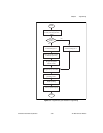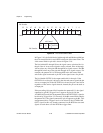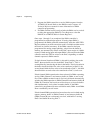
Chapter 5 Programming
©
National Instruments Corporation 5-37 AT-MIO-16X User Manual
If any digital I/O line is not driven, it floats to an indeterminate value.
If more than one device is driving any digital I/O line, the voltage at that
line may also be indeterminate. In these cases, the digital line has no
meaningful logic value, and reading the Digital Input Register may
return either 1 or 0 for the state of the digital line.
Programming the Am9513A Counter/Timer
Counters 1, 2, and 5 of the Am9513A Counter/Timer are available for
general-purpose timing applications. The programmable frequency
output pin FOUT is also available as a timing signal source. These
applications and a general description of the Am9513A Counter/Timer
are included in the Timing Connections for Data Acquisition and
Analog Output section in Chapter 2, Configuration and Installation.
The Timing I/O Circuitry section in Chapter 3, Theory of Operation,
explains how the Am9513A is used on the AT-MIO-16X board.
Initialization of the Am9513A as required by the AT-MIO-16X and
specific programming requirements for the sample-interval and sample
counters are given earlier in this chapter. For general programming
details for Counters 1, 2 and 5, and the programmable frequency output,
refer to Appendix C, AMD Am9513A Data Sheet.
In programming the Master Mode Register, keep the following
considerations in mind:
• The Am9513A must be used in 16-bit bus mode.
• The scaler control should be set to BCD division for correct
operation of the clocks as shown in Figure 5-1.
RTSI Bus Trigger Line Programming Considerations
The RTSI switch connects signals on the AT-MIO-16X to the seven
RTSI bus trigger lines. The RTSI switch has seven pins labeled A<6..0>
connected to AT-MIO-16X signals and seven pins labeled B<6..0>
connected to the seven RTSI bus trigger lines. Table 5-2 shows the
signals connected to each pin.


















